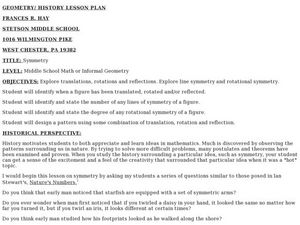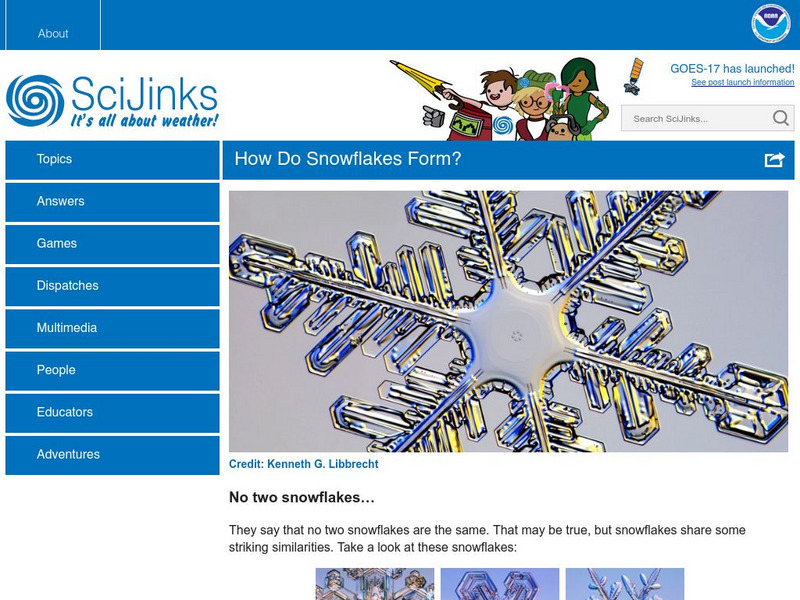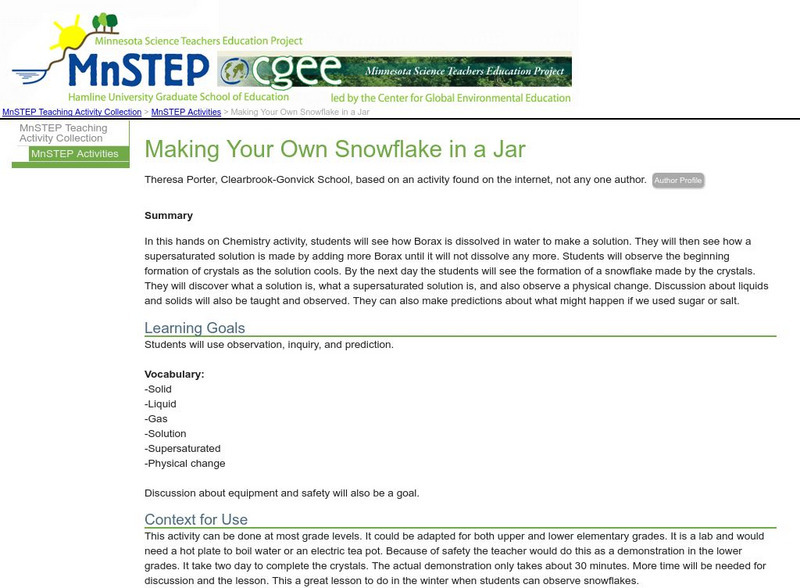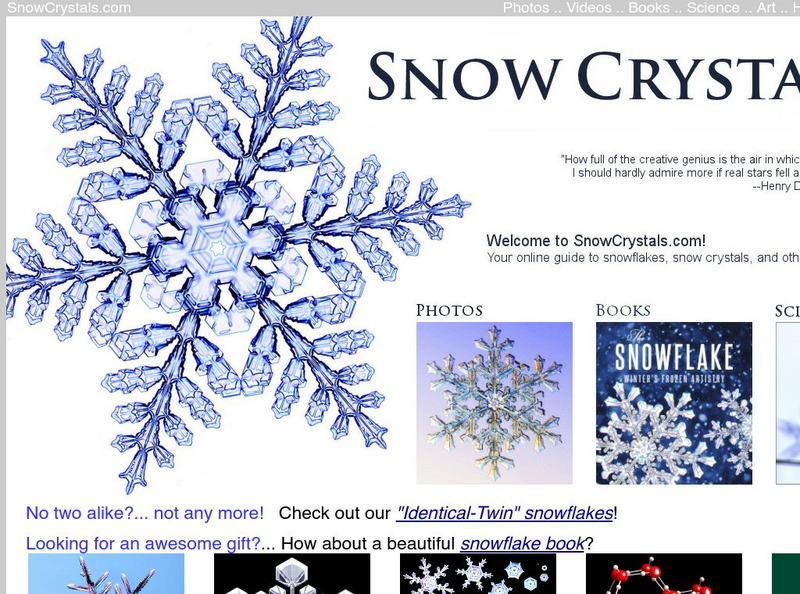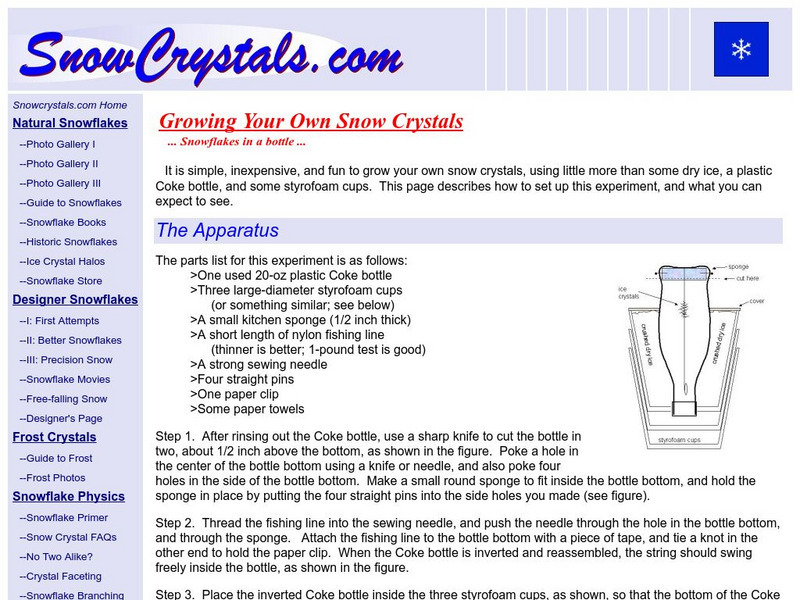Curated OER
Science: Suddenly Snow
Students engage in snow-related activities during the first winter snowfall. After explaining the elements needed for it to snow, they preserve snowflakes on frozen slides and observe them under a microscope. Then, they write diamante...
Polar Trec
Polar Detectives: Using Ice Core Data to Decode Past Climate Mysteries
How does examining an ice core tell us about weather? Learners set up and explore fake ice cores made of sugar, salt, and ash to represent historical snowfall and volcanic eruptions. From their setups, scholars determine what caused the...
Curated OER
Word Unscramble Book "Snowflake Bentley"
In this vocabulary unscramble worksheet, students unscramble 24 words. These are related to the photographer Wilson Bentley. There is no word bank.
Curated OER
Winter Wonderland - Winter Olympics and the Water Cycle
After a concise introduction to the water cycle, junior meteorologists access NOAA's average snowfall data. They choose a city to examine in terms of precipitation. Then they look at historical snowfall data and use it to predict snow...
World Wildlife Fund
Arctic Take 6
The magic number is six! Using a 6x table, young math stars practice adding, subtracting, multiplying, and dividing two-digit numbers with the number six. This worksheet also touches on making tessellations with hexagons.
Curated OER
Drip... Drop... Raindrops
Students demonstrate the steps of evaporation, cloud formation, and precipitation within the water cycle. They make and demonstrate how to use a hygrometer to record daily humidity and describe how rain, snow, and sleet form.
Curated OER
Weather - Clouds and Precipitation
It's raining! It's pouring! Your class will not be snoring when viewing this presentation. Cloud formation and types are explained in the first half. Forms of precipitation are detailed in the second half. Concepts are explained...
Curated OER
Winter
High schoolers explore the nature of water and water molecules. They examine the role of ice on organisms.
Curated OER
Geometry History Lesson
Tenth graders investigate the early history of geometry. In this geometry lesson, 10th graders investigate translations, rotations, and reflections. They also solve problems with line of symmetry and rotational symmetry while reviewing...
Curated OER
Winter Facts Scavenger Hunt
In this winter facts worksheet, students use provided links to find answer to 17 winter related questions. Two bonus questions are included.
Curated OER
Electronic Geometry Notebook
Students examine the relationship between two and three dimensional shapes. They use their drawings to solve problems. They create a notebook of the formulas and how they relate to the real world.
Curated OER
The Water Cycle/States of Matter
Learners engage in a lesson that is concerned with the water cycle and different states of matter. They conduct research using a variety of resources in preparation for taking a quiz. Then students take the quiz in correlation to having...
NASA
Sci Jinks: Grow Snow Crystals
Discover how snowflakes are created. Use this interactive to recognize the role temperature plays in the formation of snow crystals.
NASA
Sci Jinks: How Do Snowflakes Form?
Is it true that no two snowflakes are alike? Take a look at the details that make up a snowflake to find out if the statement holds any truth.
University Corporation for Atmospheric Research
Ucar: Catching Snowflakes
Are you in a place where snow falls in winter? If so, try catching snowflakes. Then take a close look. Can you find two snowflakes that look alike?
Scientific American
Scientific American Slideshow: No Two Alike: Snowflake Photography
See a variety of beautiful snowflake images demonstrating how each one is different in this slideshow from Scientific American.
Science Education Resource Center at Carleton College
Serc: Making Your Own Snowflake in a Jar
For this activity, students will learn about supersaturated solutions. They will observe the beginning formation of crystals as the solution cools and by the next day, the students will see the formation of a snowflake made by the crystals.
University of Wisconsin
The Why Files: The Curious Growth of a Snow Crystal
Explore how snowflake crystal shapes depend on the temperature of the cloud.
TED Talks
Ted: Ted Ed: The Science of Snowflakes
One could say that snowflakes are simply frozen water - but if you compare a snowflake to an ice cube, you'll notice a big difference. Why are all snowflakes six-sided? Why are none of them exactly the same? And how do we ski on them?...
University Corporation for Atmospheric Research
Ucar: Snowflakes
Learn about snowflakes and how they are formed.
Science Fun for Everyone
Science Fun: Snowflakes
Make your own snowflake with this science experiment!
California Institute of Technology
Guide to Snowflakes
No two snowflakes are the same, but they may have the same form. Learn about the basic forms of snowflakes as well as how some scientists classify them. Explore the site to find out other information as well.
California Institute of Technology
Things You Always Wanted to Know About Snow Crystals
Have you ever wondered if it's true that no two snowflakes are ever the same or why snow is white? Find out the answers to these questions and others here!
California Institute of Technology
Growing Your Own Snow Crystals
No two snowflakes are the same! Find out if that statement is true by "growing" your own snow flakes and comparing them. You need a coke bottle, dry ice and a Styrofoam cup.










